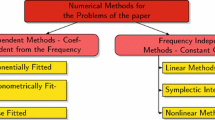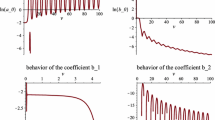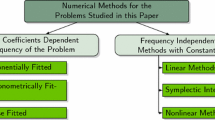Abstract
A low computational cost eighth algebraic order hybrid two-step method with vanished phase-lag and its first, second, third and fourth derivatives is developed in this paper. We also investigate the local truncation error, the stability and the result of the elimination of the phase-lag and its derivatives on the effectiveness of the produced method.


Similar content being viewed by others
Notes
where \(S\) is a set of distinct points
References
Z.A. Anastassi, T.E. Simos, A parametric symmetric linear four-step method for the efficient integration of the Schrödinger equation and related oscillatory problems. J. Comput. Appl. Math. 236, 3880–3889 (2012)
A.D. Raptis, T.E. Simos, A four-step phase-fitted method for the numerical integration of second order initial-value problem. BIT 31, 160–168 (1991)
D.G. Quinlan, S. Tremaine, Symmetric multistep methods for the numerical integration of planetary orbits. Astron. J. 100(5), 1694–1700 (1990)
J.M. Franco, M. Palacios, J. Comput. Appl. Math. 30, 1 (1990)
J.D. Lambert, Numerical Methods for Ordinary Differential Systems, The Initial Value Problem (Wiley, Chichester, 1991)
E. Stiefel, D.G. Bettis, Stabilization of Cowell’s method. Numer. Math. 13, 154–175 (1969)
G.A. Panopoulos, Z.A. Anastassi, T.E. Simos, Two new optimized eight-step symmetric methods for the efficient solution of the Schrödinger equation and related problems. MATCH Commun. Math. Comput. Chem. 60(3), 773–785 (2008)
G.A. Panopoulos, Z.A. Anastassi, T.E. Simos, Two optimized symmetric eight-step implicit methods for initial-value problems with oscillating solutions. J. Math. Chem. 46(2), 604–620 (2009)
T.E. Simos, P.S. Williams, Bessel and Neumann fitted methods for the numerical solution of the radial Schrödinger equation. Comput. Chem. 21, 175–179 (1977)
T.E. Simos, J. Vigo-Aguiar, A dissipative exponentially-fitted method for the numerical solution of the Schrödinger equation and related problems. Comput. Phys. Commun. 152, 274–294 (2003)
T.E. Simos, G. Psihoyios, J. Comput. Appl. Math. 175(1), IX–IX (2005)
T. Lyche, Chebyshevian multistep methods for ordinary differential eqations. Numer. Math. 19, 65–75 (1972)
T.E. Simos, P.S. Williams, A finite-difference method for the numerical solution of the Schrödinger equation. J. Comput. Appl. Math. 79, 189205 (1997)
R.M. Thomas, Phase properties of high order almost P-stable formulae. BIT 24, 225238 (1984)
J.D. Lambert, I.A. Watson, Symmetric multistep methods for periodic initial values problems. J. Inst. Math. Appl. 18, 189202 (1976)
A. Konguetsof, T.E. Simos, A generator of hybrid symmetric four-step methods for the numerical solution of the Schrödinger equation. J. Comput. Appl. Math. 158(1), 93–106 (2003)
Z. Kalogiratou, T. Monovasilis, T.E. Simos, Symplectic integrators for the numerical solution of the Schrödinger equation. J. Comput. Appl. Math. 158(1), 83–92 (2003)
Z. Kalogiratou, T.E. Simos, Newton-Cotes formulae for long-time integration. J. Comput. Appl. Math. 158(1), 75–82 (2003)
G. Psihoyios, T.E. Simos, Trigonometrically fitted predictor-corrector methods for IVPs with oscillating solutions. J. Comput. Appl. Math. 158(1), 135–144 (2003)
T.E. Simos, I.T. Famelis, C. Tsitouras, Zero dissipative, explicit Numerov-type methods for second order IVPs with oscillating solutions. Numer. Algorithms 34(1), 27–40 (2003)
T.E. Simos, Dissipative trigonometrically-fitted methods for linear second-order IVPs with oscillating solution. Appl. Math. Lett. 17(5), 601–607 (2004)
K. Tselios, T.E. Simos, Runge–Kutta methods with minimal dispersion and dissipation for problems arising from computational acoustics. J. Comput. Appl. Math. 175(1), 173–181 (2005)
D.P. Sakas, T.E. Simos, Multiderivative methods of eighth algrebraic order with minimal phase-lag for the numerical solution of the radial Schrödinger equation. J. Comput. Appl. Math. 175(1), 161–172 (2005)
G. Psihoyios, T.E. Simos, A fourth algebraic order trigonometrically fitted predictor-corrector scheme for IVPs with oscillating solutions. J. Comput. Appl. Math. 175(1), 137–147 (2005)
Z.A. Anastassi, T.E. Simos, An optimized Runge–Kutta method for the solution of orbital problems. J. Comput. Appl. Math. 175(1), 1–9 (2005)
T.E. Simos, Closed Newton–Cotes trigonometrically-fitted formulae of high order for long-time integration of orbital problems. Appl. Math. Lett 22(10), 1616–1621 (2009)
S. Stavroyiannis, T.E. Simos, Optimization as a function of the phase-lag order of nonlinear explicit two-step P-stable method for linear periodic IVPs. Appl. Numer. Math. 59(10), 2467–2474 (2009)
T.E. Simos, Exponentially and trigonometrically fitted methods for the solution of the Schrödinger equation. Acta Appl. Math. 110(3), 1331–1352 (2010)
T. E. Simos, New stable closed Newton–Cotes trigonometrically fitted formulae for long-time integration. Abstr. Appl. Anal. 2012, Article ID 182536, 15 (2012). doi:10.1155/2012/182536
T.E. Simos, Optimizing a hybrid two-step method for the numerical solution of the Schrödinger equation and related problems with respect to phase-lag. J. Appl. Math. 2012, Article ID 420387, 17 (2012). doi:10.1155/2012/420387
Z.A. Anastassi, T.E. Simos, A parametric symmetric linear four-step method for the efficient integration of the Schrödinger equation and related oscillatory problems. J. Comput. Appl. Math. 236, 38803889 (2012)
D.F. Papadopoulos, T.E. Simos, A modified Runge–Kutta-Nyström method by using phase lag properties for the numerical solution of orbital problems. Appl. Math. Inf. Sci. 7(2), 433–437 (2013)
T. Monovasilis, Z. Kalogiratou, T.E. Simos, Exponentially fitted symplectic Runge–Kutta–Nyström methods. Appl. Math. Inf. Sci. 7(1), 81–85 (2013)
G.A. Panopoulos, T.E. Simos, An optimized symmetric 8-step semi-embedded predictor–corrector method for IVPs with oscillating solutions. Appl. Math. Inf. Sci. 7(1), 73–80 (2013)
D.F. Papadopoulos, T.E Simos, The use of phase lag and amplification error derivatives for the construction of a modified Runge–Kutta–Nyström method. Abstr. Appl. Anal. Article Number: 910624 (2013)
I. Alolyan, Z.A. Anastassi, T.E. Simos, A new family of symmetric linear four-step methods for the efficient integration of the Schrödinger equation and related oscillatory problems. Appl. Math. Comput. 218(9), 5370–5382 (2012)
I. Alolyan, T.E. Simos, A family of high-order multistep methods with vanished phase-lag and its derivatives for the numerical solution of the Schrödinger equation. Comput. Math. Appl. 62(10), 3756–3774 (2011)
C. Tsitouras, I.T. Famelis, T.E. Simos, On modified Runge–Kutta trees and methods. Comput. Math. Appl. 62(4), 2101–2111 (2011)
A.A. Kosti, Z.A. Anastassi, T.E. Simos, Construction of an optimized explicit Runge–Kutta-Nyström method for the numerical solution of oscillatory initial value problems. Comput. Math. Appl. 61(11), 3381–3390 (2011)
Z. Kalogiratou, T. Monovasilis, T.E. Simos, New modified Runge–Kutta–Nystrom methods for the numerical integration of the Schrödinger equation. Comput. Math. Appl. 60(6), 1639–1647 (2010)
T. Monovasilis, Z. Kalogiratou, T.E. Simos, A family of trigonometrically fitted partitioned Runge–Kutta symplectic methods. Appl. Math. Comput. 209(1), 91–96 (2009)
T.E. Simos, High order closed Newton–Cotes trigonometrically-fitted formulae for the numerical solution of the Schrödinger equation. Appl. Math. Comput. 209(1), 137–151 (2009)
A. Konguetsof, T.E. Simos, An exponentially-fitted and trigonometrically-fitted method for the numerical solution of periodic initial-value problems. Comput. Math. Appl. 45(1–3), 547–554 Article Number: PII S0898–1221(02)00354–1 (2003)
T.E. Simos, On the explicit four-step methods with vanished phase-lag and its first derivative. Appl. Math. Inf. Sci. 8(2), 447–458 (2014)
G.A. Panopoulos, T.E. Simos, A new optimized symmetric embedded predictor–corrector method (EPCM) for initial-value problems with oscillatory solutions. Appl. Math. Inf. Sci. 8(2), 703–713 (2014)
L. Gr. Ixaru, M. Rizea, Comparison of some four-step methods for the numerical solution of the Schrödinger equation. Comput. Phys. Commun. 38(3), 329–337 (1985)
L.G. Ixaru, M. Micu, Topics in Theoretical Physics (Central Institute of Physics, Bucharest, 1978)
L.G. Ixaru, M. Rizea, A Numerov-like scheme for the numerical solution of the Schrödinger equation in the deep continuum spectrum of energies. Comput. Phys. Commun. 19, 23–27 (1980)
J.R. Dormand, M.E.A. El-Mikkawy, P.J. Prince, Families of Runge–Kutta–Nyström formulae. IMA J. Numer. Anal. 7, 235–250 (1987)
J.R. Dormand, P.J. Prince, A family of embedded Runge Kutta formulae. J. Comput. Appl. Math. 6, 19–26 (1980)
G.D. Quinlan, S. Tremaine, Symmetric multistep methods for the numerical integration of planetary orbits. Astron. J. 100, 1694–1700 (1990)
A.D. Raptis, A.C. Allison, Exponential-fitting methods for the numerical solution of the Schrödinger equation. Comput. Phys. Commun. 14, 1–5 (1978)
M.M. Chawla, P.S. Rao, An Noumerov-typ method with minimal phase-lag for the integration of second order periodic initial-value problems II Explicit Method. J. Comput. Appl. Math. 15, 329–337 (1986)
M.M. Chawla, P.S. Rao, An explicit sixth-order method with phase-lag of order eight for \(y^{\prime \prime }=f(t, y)\). J. Comput. Appl. Math. 17, 363–368 (1987)
T.E. Simos, A new Numerov-type method for the numerical solution of the Schrödinger equation. J. Math. Chem. 46, 981–1007 (2009)
A. Konguetsof, Two-step high order hybrid explicit method for the numerical solution of the Schrödinger equation. J. Math. Chem. 48, 224252 (2010)
A.D. Raptis, J.R. Cash, A variable step method for the numerical integration of the one-dimensional Schrödinger equation. Comput. Phys. Commun. 36, 113–119 (1985)
A.C. Allison, The numerical solution of coupled differential equations arising from the Schrödinger equation. J. Comput. Phys. 6, 378–391 (1970)
R.B. Bernstein, A. Dalgarno, H. Massey, I.C. Percival, Thermal scattering of atoms by homonuclear diatomic molecules. Proc. R. Soc. Ser. A 274, 427–442 (1963)
R.B. Bernstein, Quantum mechanical (phase shift) analysis of differential elastic scattering of molecular beams. J. Chem. Phys. 33, 795–804 (1960)
T.E. Simos, Exponentially fitted Runge–Kutta methods for the numerical solution of the Schrödinger equation and related problems. Comput. Mater. Sci. 18, 315–332 (2000)
J.R. Dormand, P.J. Prince, A family of embedded Runge–Kutta formula. J. Comput. Appl. Math. 6, 19–26 (1980)
Jing Ma, T.E. Simos, Runge–Kutta type eighth algebraic order method with vanished phase-lag and its first, second and third derivatives for the numerical solution of the radial Schrödinger equation and related problems. Appl. Math. Inf. Sci. (in press)
Conflict of interest
The authors declare that they have no conflict of interest.
Author information
Authors and Affiliations
Corresponding author
Additional information
Authors whose names appear on the submission have contributed sufficiently to the scientific work and therefore share collective responsibility and accountability for the results.
Highly Cited Researcher (http://isihighlycited.com/), Active Member of the European Academy of Sciences and Arts. Active Member of the European Academy of Sciences. Corresponding Member of European Academy of Arts, Sciences and Humanities.
Appendix: Formulae of the derivatives of \(q_{n}\)
Appendix: Formulae of the derivatives of \(q_{n}\)
Formulae of the derivatives which presented in the formulae of the LTEs:
Rights and permissions
About this article
Cite this article
Ning, H., Simos, T. A low computational cost eight algebraic order hybrid method with vanished phase-lag and its first, second, third and fourth derivatives for the approximate solution of the Schrödinger equation. J Math Chem 53, 1295–1312 (2015). https://doi.org/10.1007/s10910-015-0489-3
Received:
Accepted:
Published:
Issue Date:
DOI: https://doi.org/10.1007/s10910-015-0489-3




